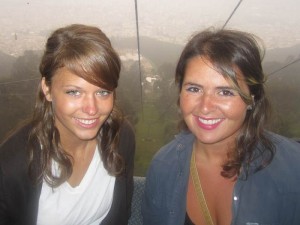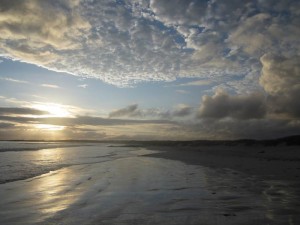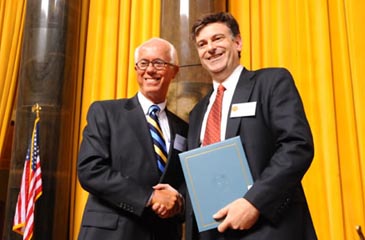
Katherine Stone and Erica Zito were able to teach in the Galapagos Islands, thanks to the Teacher Education Honors Academy.
The Galapagos Islands, off the coast of Ecuador, are home to some of the most extraordinary species in the world. For the past couple of years, a certain new species has been popping up on the archipelago—the CSI Teacher Education Honors Academy (TEHA) student.
This rare but extraordinary breed of student has been traveling to the Galapagos for two years now, spending 30 days at a time assistant teaching at La Escuela Tomas de Berlanga, a K-12 school situated in the highlands of Santa Cruz, one of the many islands that make up the Galapagos archipelago.
This past December, the CSI TEHA sent two students, Katherine Stone and Erica Zito, to the Galapagos for 30 days where they taught math and biology to the students of Tomas de Berlanga but learned to live away from the relatively safe confines of the CSI campus community.

On the island of Bartolome, Stone and Zito were able to experience the true magical essence of Galapagos. "The further away from the humans the more enchanting the Galapagos becomes," notes Zito.
“The Galapagos weren’t what we thought they would be,” said Zito, one of the TEHA students and a Brooklyn native. “It seems torn between conservation and tourism.” Ms. Zito said the main reason for her participating in the program was, as a Biology major, “how could I not? We were able to live what Charles Darwin experienced” approximately 150 years ago.
Stone, the other TEHA student and a Staten Island native, had never ventured too far without friends or family and was ready to take advantage of the exciting opportunity to visit the Galapagos. “This was the first time I left the country,” she said.
The collaboration between Tomas de Berlanga and CSI began several years ago when CSI Professor of Education Dr. Susan Sullivan and her colleague and friend, Sheila Roberts, the newly appointed and first-ever bilingual director of Tomas de Berlanga, received funding to send two students to the Galapagos on an assistant teaching grant. Dr. Sullivan’s dream of one day making this a yearly grant seems to be becoming a reality with the Harcourt Foundation providing funding for Zito and Stone.
The two students traveled to Santa Cruz in December to begin month-long stints as student teachers to the approximately 120 students that make up the school’s classes, which were all held outdoors with the ages of the students varying significantly. Both CSI students have some background in Spanish but were quick to realize how accommodating their students and fellow teachers were. “The students and teachers were so helpful,” Zito said.
“Math is a little easier to teach if you’re not fluent in the language,” said Stone, who taught seventh-, eighth, and ninth-grade math in Spanish as well as a beginner’s English class. Zito taught tenth-grade biology and advanced English and also tended the community garden.

Katie and Erica's last night on Galapagos surrounded by all the amazing friends they made during their time on Galapagos. Everyone enjoying one last "cono double chocolate" before saying goodbye. Bottom from left: Andrew, Andrea, Dani, Nick, Daemon. Top from left: Erica, Ivan, Mari, Celsey, Katie.
It wasn’t all work for the TEHA student teachers, as they spent much of their free time exploring their surroundings and getting to know each other. Although the young women were nearly strangers at the outset of the trip, they soon became fast friends. “Being around Erica really helped me get over my homesickness,” admitted Stone. The two went snorkeling with white tip reef sharks and even went on a tour of the Ecuadorian President’s house in Quito. For Zito, the highlight of the trip was spotting Daphne Major, an island made famous by the research on finches performed by Peter and Rosemary Grant. “I can’t wait to bring this experience to my students in the States,” she said.
Both students are using the experiences that they had in the Galapagos as a stepping-off point in their careers as teachers in the U.S. Stone, who is teaching trigonometry at CSI High School for International Studies, said that her main reason for making the trip was that she “wanted to see how school systems work in other countries.”
Zito, who is currently teaching ninth-grade living environment at Curtis High School, is still struck by the amount of social interaction she had with her students in the Galapagos. “My students taught me a lot.”
“One of the perks of being a member of the TEHA is this trip to the Galapagos,” said Dr. Jane Coffee, Professor of Mathematics and Director of the TEHA. “But one of the perks of visiting the Galapagos is taking home all of those incredible experiences.”
















